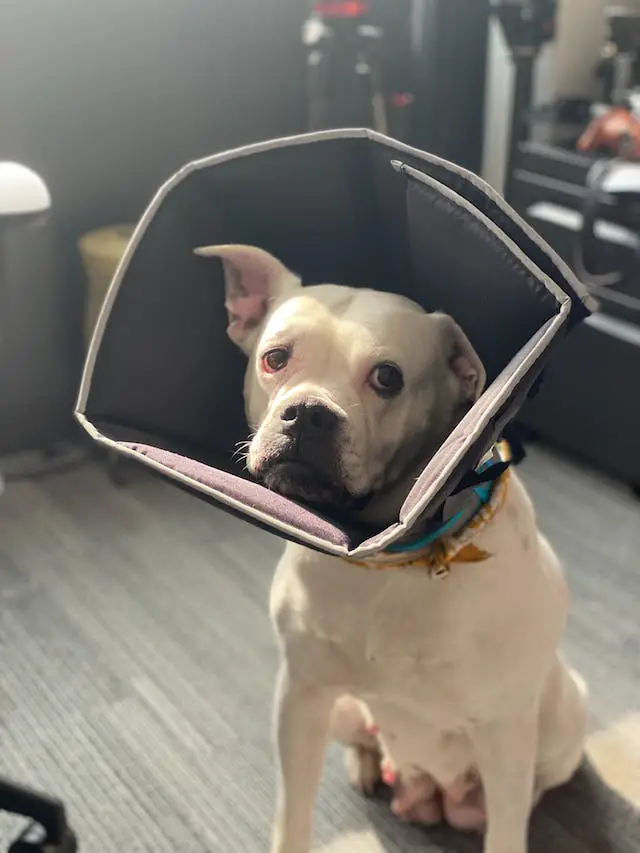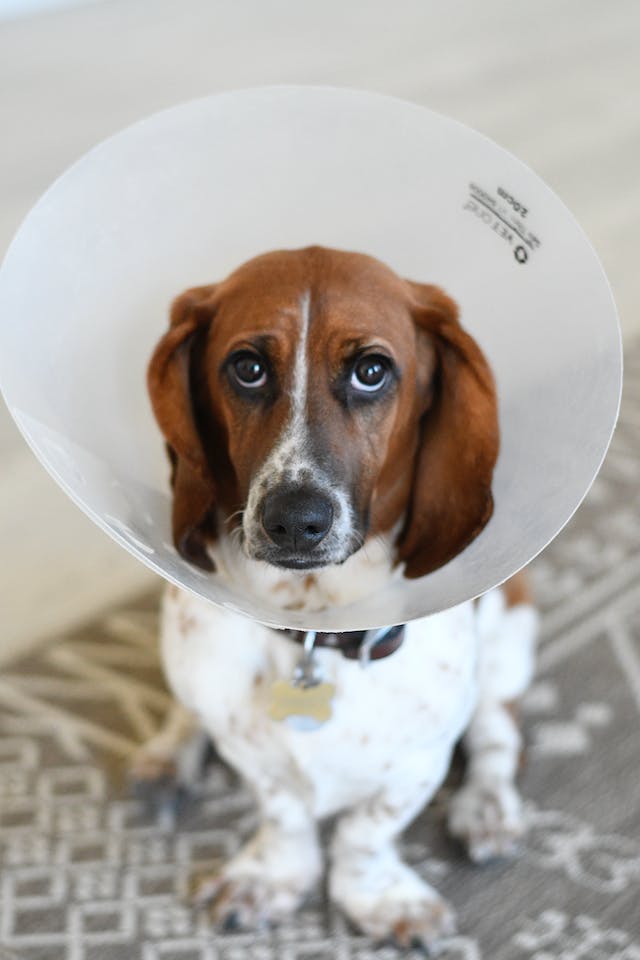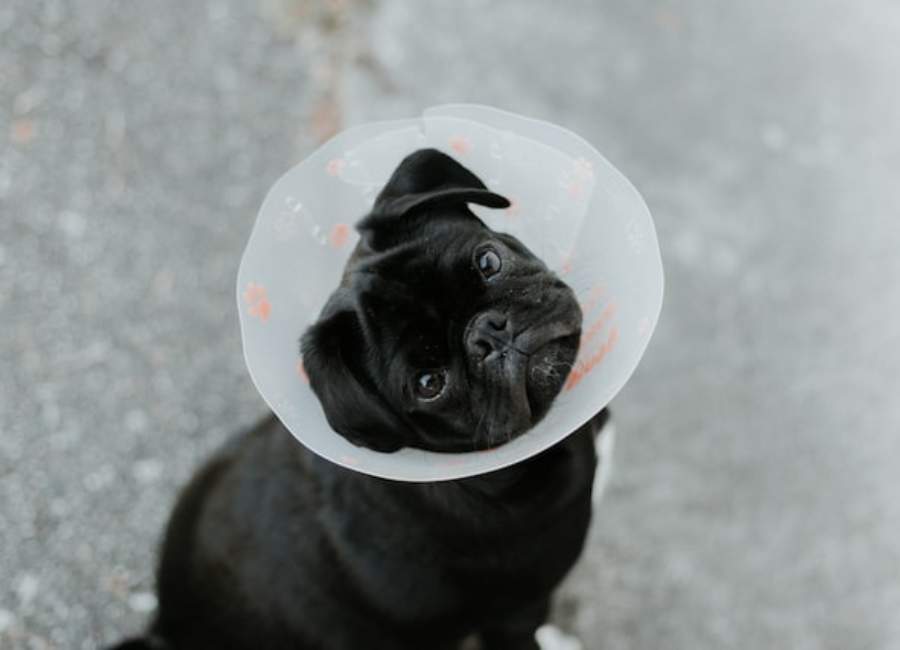Why is my dog traumatized after spay? Let’s find out together…
Today, we’re diving into a topic that hits close to home for many of us – the emotional rollercoaster our dog traumatized after a spay procedure.
Join me as we explore the heartwarming journey of a dog who overcame trauma and found her way back to happiness. Trust me, this is a story you won’t want to miss!
Dog Traumatized After Spay
After a spay surgery, dogs may experience temporary behavioral changes or exhibit signs of trauma.
This can be due to the stress of the surgical procedure, the effects of anesthesia, or discomfort during the recovery period.
The hormonal changes resulting from the spay surgery can also contribute to behavioral shifts.
It is important to provide a calm and supportive environment for your dog during the recovery phase and consult with a veterinarian if the behavioral changes persist or worsen.
Signs of Trauma in Dogs After Spaying

The following are some of the most common signs of trauma in dogs after spaying:
1. Vaginal discharge: After spaying, dogs may experience a small amount of clear or slightly bloody discharge from their incision site. However, if the discharge becomes excessive, foul-smelling, or has an abnormal color (such as green or pus-like), it could indicate an infection or other complications. It’s important to monitor the discharge and consult a veterinarian if there are any concerns.
2. Pain or discomfort: Dogs may exhibit signs of pain or discomfort after spaying. This can manifest as vocalization, restlessness, or reluctance to move. They may also exhibit behaviors such as panting, trembling, or guarding the incision site. Pain medication prescribed by a veterinarian can help alleviate these symptoms and promote a faster recovery.
3. Swelling or inflammation: It’s common for some degree of swelling or inflammation to occur around the incision site after spaying. However, excessive swelling, redness, or heat around the incision area could indicate trauma or infection. It’s important to carefully monitor the incision site and report any abnormal changes to a veterinarian.
4. Licking or chewing at the incision site: Dogs may engage in excessive licking or chewing at the incision site, which can cause self-inflicted trauma. While it is normal for dogs to groom themselves, excessive licking or chewing can delay healing, introduce bacteria, and increase the risk of infection. An Elizabethan collar or other protective measures may be necessary to prevent this behavior.
5. Loss of appetite: Trauma after spaying can lead to a temporary loss of appetite in dogs. The stress from the surgery, altered hormone levels, and pain can affect their desire to eat. It’s important to monitor their food and water intake and consult a veterinarian if the loss of appetite persists or is accompanied by other concerning symptoms.
6. Behavioral changes: Dogs may exhibit behavioral changes after spaying. These changes can be a result of the trauma from the surgery and the hormonal adjustments that occur. Some dogs may become more lethargic or withdrawn, while others may exhibit increased aggression or anxiety. These behavioral changes are usually temporary and should resolve as the dog recovers.
7. Fever or elevated body temperature: Dogs experiencing trauma after spaying may develop a fever or have an elevated body temperature. A normal body temperature for dogs ranges between 100.5°F and 102.5°F. If a dog’s temperature exceeds 103°F or if they display other signs of illness, such as loss of appetite or lethargy, it’s important to consult a veterinarian promptly.
Remember that these signs can vary in severity and may not always indicate trauma after spaying. However, if you notice any of these signs in your dog after the procedure, it’s best to consult a veterinarian for a thorough examination and appropriate treatment.
Why Dogs Can Become Traumatized After Spaying
Dogs can become traumatized after spaying due to a combination of physical and psychological factors. The surgical procedure itself can be stressful for the dog, causing pain and discomfort during the recovery period.
Additionally, the hormonal changes that occur after spaying can affect the dog’s behavior and mood. Dogs may experience anxiety, fear, and confusion as they adjust to the sudden decrease in hormone levels.
The loss of reproductive capability can also have an emotional impact on some dogs, leading to feelings of loss or sadness.
It is important for owners to provide a supportive and comforting environment for their dogs during the recovery process to help minimize any potential trauma.
Ways to Help a Dog Cope with Trauma After Spaying

While the recovery process after spaying can vary for each dog, here are some ways to help a dog cope with trauma after spaying:
1. Provide Comfort and Reassurance: Dogs may experience anxiety or discomfort after surgery. Providing comforting words and gestures can help them cope with their emotional challenges. However, it’s important to note that comforting a fearful dog does not reinforce fear.
2. Minimize Stress: Stress can impede a dog’s recovery after surgery. Minimizing stress levels can help the dog heal faster. Creating a calm and quiet environment, avoiding rushing socialization, and allowing the dog to recover at their own pace can be beneficial.
3. Use a Recovery Cone: Dogs may try to lick or chew their incision site, which can lead to complications. Using a recovery cone, also known as an Elizabethan collar, can prevent self-trauma and protect the incision. There are alternative collars available, such as padded collars, which may be more comfortable for the dog.
4. Monitor Activity: It’s important to monitor the dog’s activity level and prevent excessive jumping, running, or rough play during the recovery period. Rest and limited activity can aid in the healing process.
5. Follow Post-Surgical Care Instructions: Following the veterinarian’s post-surgical care instructions is crucial for the dog’s recovery. This may include administering medication, keeping the incision clean, and avoiding baths or swimming until the incision has fully healed.
6. Provide Physical and Mental Stimulation: While the dog needs rest during the recovery period, it’s also important to provide appropriate physical and mental stimulation to prevent boredom. Engaging in gentle activities, such as short walks or puzzle toys, can help keep the dog mentally and physically stimulated without putting strain on the incision site.
Preventing Spay Trauma in Dogs
To ensure a safe and successful spay surgery, several measures can be taken to prevent spay trauma in dogs.
These measures include proper anesthesia, post-surgery care, pain management, and regular check-ups.
Let’s take a quick look at these steps:
1. Proper Anesthesia
Proper anesthesia is crucial during spay surgery to ensure the dog remains unconscious and pain-free throughout the procedure.
Anesthesia allows the veterinarian to perform the surgery without causing distress or pain to the dog.
It is important to use appropriate anesthesia protocols tailored to the individual dog’s needs, taking into account factors such as age, breed, and overall health.
2. Post-Surgery Care
Post-surgery care plays a vital role in preventing spay trauma and promoting a smooth recovery for the dog. Some important aspects of post-surgery care include:
- Monitoring: After the surgery, the dog should be closely monitored for any signs of complications or distress. This includes checking vital signs, such as heart rate and respiration, and observing the incision site for any signs of infection or excessive swelling.
- Rest and Restriction: Dogs should be kept in a quiet and comfortable environment to allow for proper rest and healing. Physical activity should be restricted to prevent excessive strain on the incision site.
- Incision Care: The incision site should be kept clean and dry. It is important to follow the veterinarian’s instructions regarding any necessary wound care, such as applying topical medications or changing dressings.
- Nutrition and Hydration: Providing a balanced diet and ensuring access to fresh water is essential for the dog’s recovery. Some dogs may have a reduced appetite after surgery, so it may be necessary to offer small, frequent meals or consult with a veterinarian regarding appropriate feeding strategies.
- Preventing Licking or Chewing: Dogs may be tempted to lick or chew at the incision site, which can lead to infection or delayed healing. The use of an Elizabethan collar or alternative methods to prevent access to the incision area may be recommended.
3. Pain Management
Proper pain management is crucial to ensure the dog’s comfort during the recovery period. Pain can not only cause distress to the dog but can also slow down the healing process.
Veterinarians may prescribe pain medications to manage post-operative pain and discomfort.
It is important for pet owners to follow the veterinarian’s instructions regarding the administration of pain medication and to report any concerns or changes in the dog’s behavior to the veterinarian.
4. Regular Check-ups
Regular check-ups with the veterinarian are important to monitor the dog’s progress and ensure proper healing.
During these check-ups, the veterinarian can assess the incision site, remove any stitches if necessary, and address any concerns or complications that may arise.
These check-ups also provide an opportunity to discuss any changes in the dog’s behavior or overall health.
Frequently Asked Questions
My dog seems traumatized after her spay surgery. Is this normal?
It’s not uncommon for dogs to experience some level of trauma after spay surgery. The procedure can be stressful for them, both physically and emotionally. However, if your dog’s behavior continues to be concerning or worsens over time, it’s important to consult with your veterinarian for further guidance.
How can I help my dog cope with the trauma of spay surgery?
There are several things you can do to help your dog cope with the trauma of spay surgery. Providing a calm and comforting environment, offering plenty of love and attention, and engaging in low-intensity activities like gentle walks or cuddling can help soothe their anxiety. Additionally, consult with your veterinarian about potential medication or behavioral therapy options that may be suitable for your dog’s specific needs.
My dog is displaying signs of fear and aggression after her spay surgery. What should I do?
Fear and aggression can sometimes be common reactions in dogs after spay surgery. It’s essential to give your dog space and avoid forcing interactions that may further stress them. Gradually reintroduce positive experiences, such as rewarding calm behavior and providing treats during gentle training sessions. If the behavior persists or worsens, consider seeking professional help from a certified dog behaviorist.
How long does it usually take for a traumatized dog to recover after spay surgery?
The recovery time for a traumatized dog after spay surgery varies from dog to dog. Some dogs may bounce back quickly, while others may take a bit longer to recover emotionally. It’s important to be patient and understanding during this process, as each dog’s healing journey is unique. If you have concerns about your dog’s progress, consult with your veterinarian for guidance.
Can I prevent my dog from getting traumatized after spay surgery?
While it’s impossible to guarantee that your dog won’t experience any trauma after spay surgery, there are steps you can take to minimize the risk. Choosing a reputable veterinarian who prioritizes the emotional well-being of animals and providing your dog with a calm and nurturing environment during the recovery period can help reduce the likelihood of trauma. Additionally, discussing pain management options with your veterinarian may also contribute to a smoother recovery.
Are there any long-term effects of trauma on dogs after spay surgery?
In most cases, dogs recover well from the trauma of spay surgery with proper care and support. However, in rare cases, some dogs may develop long-term behavioral issues such as anxiety or fear aggression. It’s important to monitor your dog’s behavior closely and seek professional help if you notice any persistent or concerning changes. Early intervention and appropriate treatment can significantly improve their quality of life.
Conclusion
In conclusion, going through a spay surgery can be a traumatic experience for our furry friends. As pet owners, it’s crucial for us to provide them with the love, care, and support they need during this time. With patience and understanding, we can help our dogs heal both physically and emotionally, ensuring a happy and healthy life ahead.


